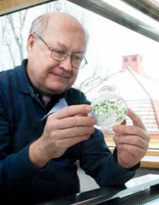Contact
 Professor Hans Ronne
Professor Hans Ronne
Department of Forest Mycology and Plant Pathology
018-673223, hans.ronne@slu.se
We are using yeast to study how anti-cancer drugs work. There are two advantages with using yeast for this kind of work. One is that yeast is a microorganism, and thus much easier to work with than mice or human cell cultures.
Second, yeast is a eukaryote and is thus more closely related to man than bacteria. This means that many things work the same way in yeast cells and human cells. Much of what is known about e.g. the cell division in human cells including tumour cells was discovered by work in yeast.
Our project aims at studying the uptake, metabolism and mechanisms of action of anti-cancer drugs by experiments in yeast, in order to develop a better understanding of how these drugs work in tumour cells, and how their usefulness may be improved. Our work is focused on 5-fluorouracil, one of the oldest and most commonly used anti-cancer drugs.

It is easier to knock out genes in yeast than in any other organism, and collections of yeast strains have therefore been made in which every gene has been knocked out, one in each strain. By screening the strains in such a collection for sensitivity or resistance to a drug, it is possible to quickly identify genes that are involved in the uptake, metabolism or mechanisms of action of the drug. This kind of profiling is an example of chemical genomics.
We have used such chemical genomics to identify genes that make the cells more sensitive to 5-fluorouracil when they are knocked out. We found that genes coding for enzymes that modify tRNA have a particularly strong effect on the sensitivity to 5-fluorouracil. This suggests that these enzymes may be targets for 5-fluorouracil. It has been shown previously that these modifications help to stabilize tRNA molecules. Our results therefore suggest that destabilization of tRNA may be one mechanism of action of 5-fluorouracil.
A major problem when using anti-cancer drugs is acquired resistance to the drug in tumour cells. This is frequently caused by overexpression of genes that cause resistance. Our work is now focused on understanding the mechanisms that cause resistance to 5-fluorouracil. For these studies we are using a reverse type of chemical genomics where we overexpress genes from plasmids instead of knocking them out. By transforming a library of such plasmids that contains different genes into yeast it is possible to identify genes that cause resistance to 5-fluorouracil when overexpressed.
By developing a better understanding of how anti-cancer drugs are taken up, metabolised and exert their action we hope to achieve three goals. One is to improve treatments with anti-cancer drugs in order to make them more efficient and more specific for the tumour cells. The second goal is to develop methods that can suppress the toxic side effects that many anti-cancer drugs have. The third goal is to develop methods that prevent the appearance of drug resistant tumour cells.
These goals can be achieved in different ways, e. g. by the combined use of an anti-cancer drug with a second drug that affects the uptake, metabolism or mechanism of action of the first drug, or counteracts its toxic side effects.
Funded by the Swedish Cancer Society
Ossig R, Schmitt HD, de Groot B, Riedel D, Keränen S, Ronne H, Grubmüller H and Jahn R (2000). Exocytosis requires asymmetry in the central layer of the SNARE complex. EMBO J. 19, 6000-6010.
Murén, E., Öyen, M., Barmark, G. and Ronne, H. (2001). Identification of yeast disruption strains that are sensitive to brefeldin A or monensin, two drugs that affect intracellular transport. Yeast 18, 163-172.
Jäntti, J., Aalto, M., Öyen, M., Sundqvist, L., Keränen, S. and Ronne, H. (2002). Characterization of temperature sensitive mutations in the yeast syntaxin homologues SSo1p and Sso2p, and evidence of a distinct function for Sso1p in sporulation. J. Cell Sci. 115, 409-420.
Meiling-Wesse, K., Barth, H., Voss, C., Barmark, G., Murén, E., Ronne, H. and Thumm, M. (2002). Yeast Mon1p/Aut12p functions in vacuolar fusion of autophagosomes and cvt-vesicles. FEBS Lett. 530, 174-180.
Öyen, M., Jäntti, J., Keränen, S. and Ronne, H. (2004). Mapping of sporulation-specific functions in the yeast syntaxin SSO1 gene. Curr. Genetics 45, 76-82.
Wadskog, I., Forsmark, A., Rossi, G., Konopka, C., Öyen, M., Goksör, M., Ronne, H., Brennwald, P. and Adler, L. (2006) The yeast tumour suppressor homologue Sro7p is required for targeting of the sodium pumping ATPase to the cell surface. Mol. Biol. Cell 17, 4988-5003.
Gustavsson, M. and Ronne, H. (2008) Evidence that tRNA modifying enzymes are important in vivo targets for 5-Fluorouracil in yeast. RNA 14, 1-9.
Gustavsson, M., Barmark, G., Larsson, J., Murén, E. and Ronne, H. (2008) Functional genomics of monensin sensitivity in yeast: implications for post-Golgi transport and vacuolar H+-ATPase function. Mol. Genet. Genomics 280, 233-248.
Zhu, X., Zhang, Y., Bjornsdottir, G., Liu, Z., Quan, A., Costanzo, M., Dávila López, M., Orzechowski Westholm, J., Ronne, H., Boone, C., Gustafsson, C. M. and Myers, L. C. (2011) Histone modifications influence mediator interactions with chromatin. Nucleic Acids Res. 39, 8342-8354.
Carlsson, M., Gustavsson, M., Hu, G.-Z., Murén, E. and Ronne, H. (2013) A Ham1p-dependent mechanism and modulation of the pyrimidine biosynthetic patway can both confer resistance to 5-fluorouracil in yeast. PloS ONE 8, e52094.
Carlsson, M., Hu, G.-Z., and Ronne, H. (2018) Gene dosage effects in yeast support broader roles for the LOG1, HAM1 and DUT1 genes in detoxification of nucleotide analogues. PLoS ONE 13: e0196840.
 Professor Hans Ronne
Professor Hans RonneDepartment of Forest Mycology and Plant Pathology
018-673223, hans.ronne@slu.se